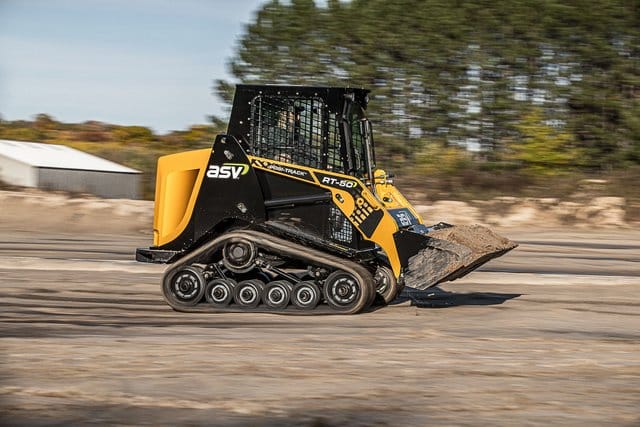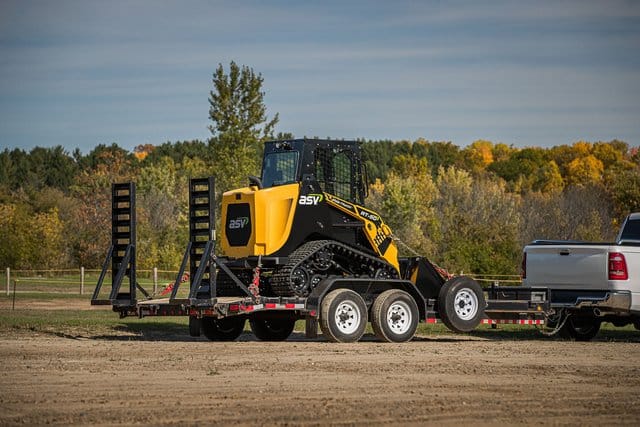Tips for Trailering: How to Select a Trailer and Hit the Road with Your Compact Track Loader
One of the many perks of compact equipment is the ability to transport it rather easily and, in most cases, without a CDL. Compact track loaders offer crews a versatile machine that excels in all sorts of applications, but it’s no use until you get it on the jobsite. To do so, you must find the right trailer to move it, and the first thing to consider when selecting a trailer is the compact track loader’s operating weight.
“The operating weight includes the weight of the machine, its fluids and the standard bucket,” says Buck Storlie, ASV product line manager. “The operator’s estimated weight is also factored into the operating weight. That means a bit of a safety factor for possible additions because the operator won’t be on the trailer. Also, be aware of how the manufacturer rates the operating weight. Does your loader include additional options? Are you hauling additional attachments? If so, these must be added to the overall weight.”
First off, make sure you have a truck that is capable of hauling what you need. Double check that your truck and its trailer hitch meet your maximum capacity requirements. Before selecting a trailer, first have a complete understanding of the track loader that you will be hauling. What is the machine’s physical length, width and weight? Will you be hauling anything else with the machine such as an extra bucket, attachments or hand tools?
The total towed weight plus the weight of the trailer must not exceed the trailer’s gross vehicle weight rating (GVWR). GVWR is the maximum weight a trailer is capable of hauling — including the weight of the trailer itself. It is determined by the manufacturer and can be found in the vehicle’s manual.
“Always use a trailer that is rated at or below the vehicle that will tow it,” says Storlie. “While it may seem like a good idea to just buy an extra-large trailer, using a tow vehicle that is rated to carry less than the trailer can violate local laws, even if the trailer is empty.”

Next up is selecting the type of trailer.
“Gooseneck trailers offer high capacities, long surfaces with a shorter turning radius, but a bumper pull or flat deck may accommodate more tow vehicles,” says Storlie. “Remember that a trailer’s rating often includes the trailer’s weight, so a trailer rated for 10,000 lbs may not actually be able to haul 10,000 lbs. You often must deduct the weight of the trailer itself to get the actual load capacity. See the manufacturer’s specifications for details.”
After you select a trailer, next is putting it to work. When loading the trailer, Storlie says to be sure to park the tow vehicle on a level surface and lock the parking brake. He also recommends using a spotter to help in the loading process. It’s important to drive the track loader slowly and be alert of the point the machine will rock onto and off the trailer ramps. If you’re towing a compact track loader and attachments, everything should be arranged to balance the weight of the load properly.
“Generally, the machine will be placed with the center of gravity slightly ahead of the axles to get the appropriate tongue weight to avoid trailer sway,” says Storlie. “Attachments should also be evenly balanced to distribute the weight over the axles.”
As for securing the load, always tie a machine down with four points of contact. Storlie emphasizes that this should include four separate chains and binders to meet legal requirements. Also, if you’re placing the machine on the trailer with the exhaust facing the tow vehicle, he says to tape or plug off the exhaust outlet.

“Wind or materials blowing into the exhaust can cause exhaust or turbocharger damage,” says Storlie. “If traveling greater distances, it’s a good idea to occasionally check the chains and tie devices, particularly shortly into the trip to ensure nothing has moved.”
For unloading the machine, Storlie reiterates the advice from the loading process: Park on a level surface, lock the parking brake and drive slowly. A spotter is helpful, too.
